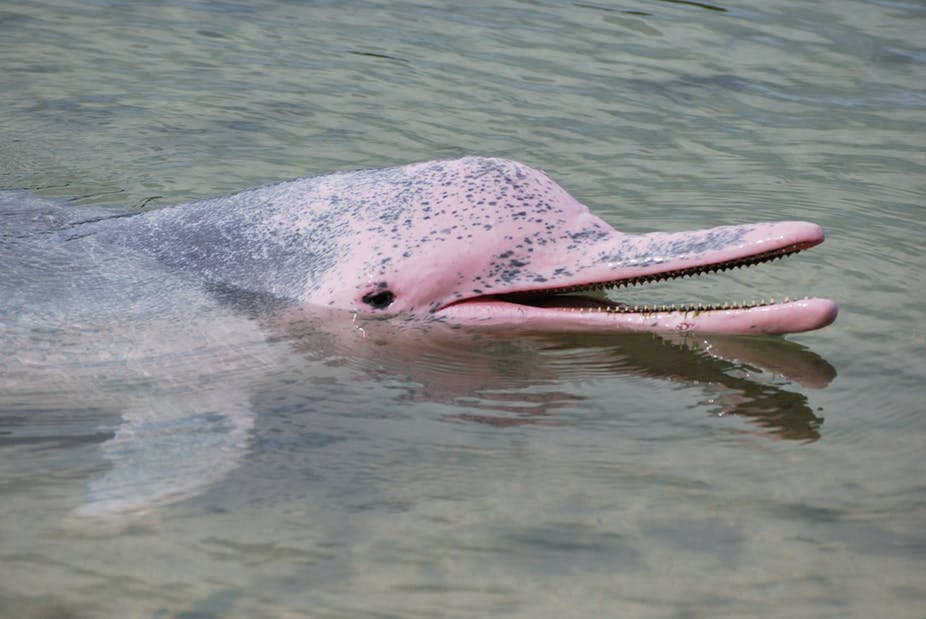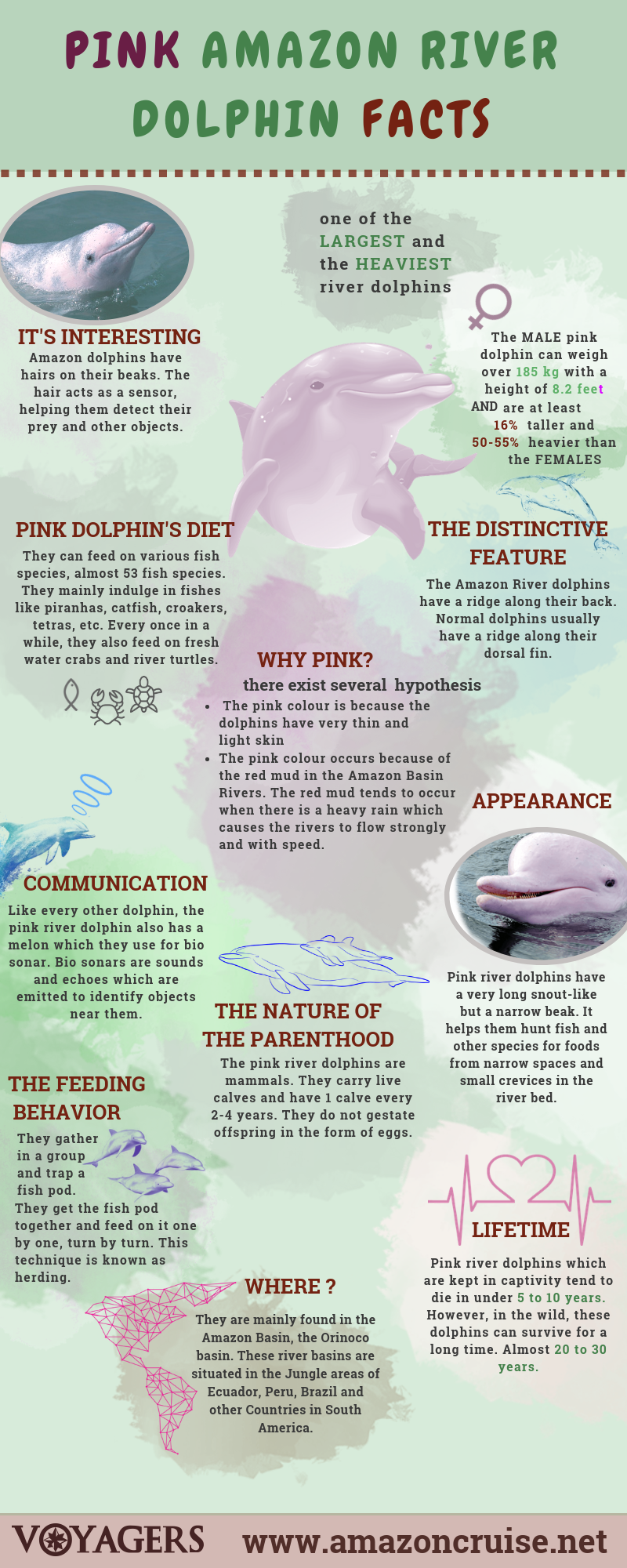

The pink Amazon River dolphin is one of the most unique species of dolphins. Of course, the main reason for its uniqueness is because of its colour. However, many people find it hard to believe that the dolphin is actually of a pink colour since it is rarely seen. Pink dolphins are also known by several other names such as the botos or bufeos. The pink Amazon River dolphin’s binomial name is Inia geoffrensis and it actually belongs to the toothed whale species, which are classified as belonging to the family of Iniidae. Currently, only 3 species of the toothed whale species have been discovered and classified in the Iniidae family. The first is the pink dolphin, the second is the Bolivian river dolphin and the third is the Orinoco river dolphin. All of these species are spread around the Amazon basin, the Madeira River in Bolivia and the Orinoco River.
Here are a few pink river dolphin’s facts which everyone needs to know:
The pink river dolphin is one of the largest and the heaviest river dolphins to ever exist. Even sexual dimorphism is the greatest amongst the males and the females.
The male pink dolphin can weigh over 185 kg with a height of 8.2 feet. They are at least 16% taller in height than the females and 50-55% heavier than the females.
The male adults even acquire the pink colour, which this Amazon River dolphin is most famous for, at a brighter tone which is more prominent.
Like every other dolphin, the pink river dolphin also has a melon which they use for bio sonar. Bio sonars are sounds and echoes which are emitted to identify objects near them. The pink river dolphin also has a dorsal fin and pectoral fins. Although they are not tall in height, they are still regarded as large.
Another pink dolphin’s info fact is that they have an extremely diverse diet. They can feed on various fish species, almost 53 fish species. They mainly indulge in fishes like piranhas, catfish, croakers, tetras, etc. Every once in a while, they also feed on fresh water crabs and river turtles.
Many people have seen the Amazon pink river dolphin in dolphinariums and zoos. It is said that currently, only 3 exist in captivity now. One in the Acuario De Valencia situated in Venezuela, one in the Zoologico de Guistochoca in Peru and the final one in Germany’s Diusburg Zoo.
Around the 1950s and 1970s, 100 of the Amazon pink river dolphins were distributed to various aquariums and dolphinariums in the USA. Only 20 survived with much difficulty.
The pink river dolphin is a mammal. It can carry babies and give birth to them. They do not produce offspring in the form of eggs. These pink river dolphins also have lungs to breath in the air, unlike fish.
A pink river dolphin’s fact which interests many people is how and why these dolphins have a pink colour. The first pink dolphin fact related to colour is that the pink river dolphins are not born pink. The baby pink dolphins are usually grey at birth. As they grow, their colour changes to pink. The males have a much starker and prominent pink colour than the females. As to why the pink river dolphins have the unique pink colour, there exist several ideas and hypothesis.
The pink colour is because the dolphins have very thin and light skin. The pink colour comes from the blood vessels beneath the skin.
The pink colour occurs because of the red mud in the Amazon Basin Rivers. The red mud tends to occur when there is a heavy rain which causes the rivers to flow strongly and with speed. Thus, colouring the Amazon River dolphin as pink.
Since these pink river dolphins tend to fight a lot amongst each other, they tend to develop a pinkish colour overtime.
Another fact about the pink dolphins is that many of them tend to have a pink colour underneath and a greyish colour on the top. These colours help them hide from dangerous predators.
The Amazon pink river dolphin is classified as ‘endangered’. It is not extinct however the population of the Amazon River dolphin exists in ten thousand or below.
Pink river dolphins which are kept in captivity tend to die in under 5 to 10 years. However, in the wild, these dolphins can survive for a long time. Almost 20 to 30 years.
The feeding behavior of the pink river dolphins is also quite unique. They gather in a group and trap a fish pod. They get the fish pod together and feed on it one by one, turn by turn. This technique is known as herding. They also spend most of their time at the river’s floor where they have full and clear access to crabs and river turtles.
A question to which the answer most people want to know is where do pink dolphins live? As the name ‘Amazon pink river dolphins’ suggests, these dolphins only live in fresh river waters. They are mainly found in the Amazon Basin, the Orinoco basin. These river basins are very commonly situated in a few places such as the Ecuador, Venezuela, Bolivia, Brazil, Columbia, etc.
The dolphins tend to make their habitats in murky waters. It serves as a natural hiding place and is great for hunting and an abundant amount of fish, crabs, and turtles.
Pink river dolphins have a very long snout-like but a narrow beak. It helps them hunt fish and other species for foods from narrow spaces and small crevices in the river bed.
The Amazon River dolphins have a ridge along their back. Normal dolphins usually have a ridge along their dorsal fin.
Amazon dolphins have hairs on their beaks. The hair acts as a sensor, helping them detect their prey and other objects.
Now, you know more about the pink Amazon River dolphins. Hope these facts give you enough information about these unique creatures.

Recent Comments